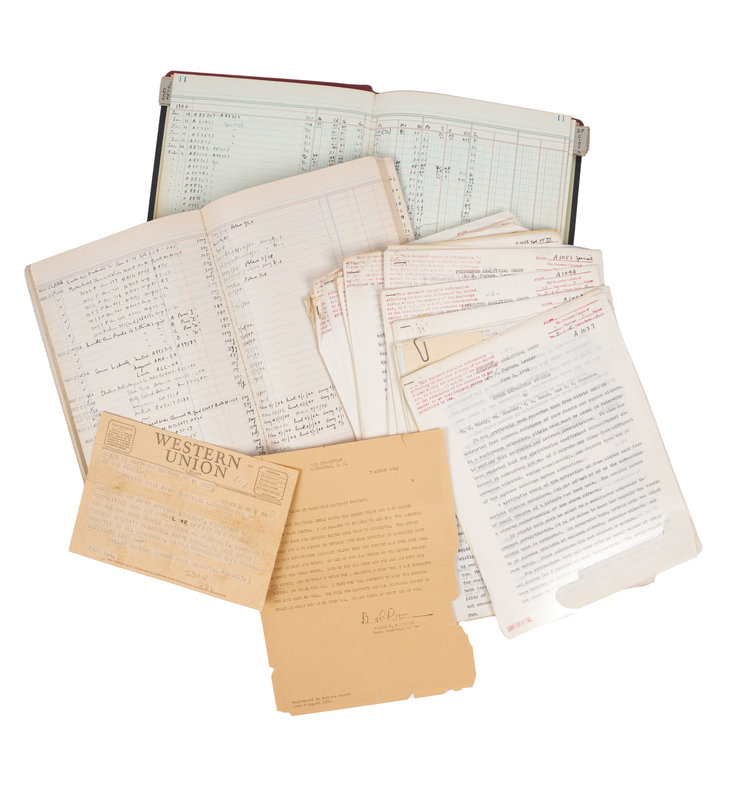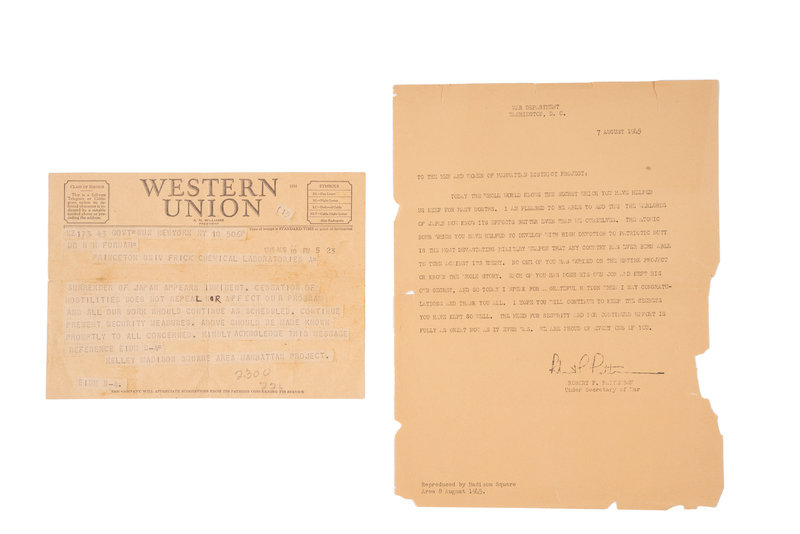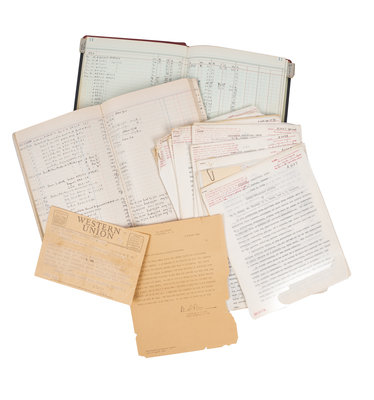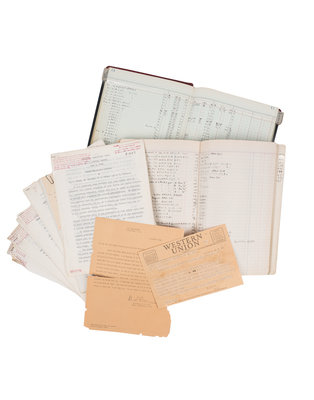Lot 633
[MANHATTAN PROJECT]. An extensive archive including laboratory notebooks, typed reports and drafts, and typed communications relating to the research activities in Princeton's Frick Laboratories for the Manhattan Project, ca 1942-1946.
Sale 1097 - Fine Printed Books & Manuscripts, Including Americana
Lots 1-410
Nov 8, 2022
9:00AM CT
Lots 411-717
Nov 9, 2022
9:00AM CT
Live / Chicago
Own a similar item?
Estimate
$5,000 -
7,000
Price Realized
$6,250
Sold prices are inclusive of Buyer’s Premium
Lot Description
[MANHATTAN PROJECT]. An extensive archive including original laboratory notebooks, typed laboratory reports and drafts, and typed communications relating to the research activities in Princeton's Frick Laboratories of the Princeton Analytical Group under the direction of Professor Nathaniel H. Furman for the Manhattan Project, ca 1942-1946.
The Manhattan Project, organized under the direction of Major General Leslie Groves, grew to employ more than 130,000 at a cost of nearly two billion dollars, and had project sites at Oak Ridge, Tennessee, Los Alamos, New Mexico, Chicago, and Hanaford, Washington, with research taking place at a network of institutions across the United States and Canada. Organized under the "Madison Square Area" of the "Manhattan District, Corps of Engineers," researchers at the Frick Laboratories in Princeton's Department of Chemistry, under the direction of Professor Nathaniel H. Furman (1892-1965), worked to identify uranium in ores and to purify and measure trace contaminants in uranium concentrates, apparently to work toward discovering uranium deposits in the United States.
Included in the archive are:
Carbon copy typescript. A letter from the War Department, signed (in facsimile) by Under secretary of War Robert P. Patterson ("Robert P. Patterson"), 7 August 1945, "To the Men and Women of Manhattan District Project." 1 page, 8vo, marginal chipping. "TODAY THE WHOLE WORLD KNOWS THE SECRET WHICH YOU HAVE HELPED US KEEP FOR MANY MONTHS." Written one day after the first atomic bomb was dropped on Hiroshima, Patterson comments: "I am pleased to be able to add that the warlords of Japan now know its effects better even than we ourselves...No one of you has worked on the entire project or known the whole story. Each of you has done his own job and keep his own secret, and so today I speak for a grateful nation when I say congratulations and thank you all."
Western Union Telegram, to Dr. Furman, 10 August 1945. "SURRENDER OF JAPAN APPEARS IMMINENT." Instructions from the Madison Square Area, Manhattan Project, instructing "Cessation of hostilities does not repeal nor affect our program and our work should continue as scheduled. Continue present security measures." Surrender would be announced by Emperor Hirohito 5 days later on 15 August 1945.
Furman's manuscript ledger recording sample data from various locations including MIT, U. S. Engineers, Westinghouse and DuPont. Entries note the type and amount of the sample, as well as dates received and reported. With 4 additional ledgers kept by Furman, ca December 1942 through February 1946, recording samples, with two ledgers labeled "Special Defense Note Book."
WITH: 4 of Nathaniel H. Furman's notebooks. Each including handwritten data from several of the project's other sites, including Ames, Iowa, Du Pont, Hooker Electro Metal Company, Linde Air Products Company, Harshaw Chemical, Mallinckrodt Chemical Works, and U. S. Engineers. -- Three composition notebooks of student calculations and data from Bruce McDuffie and Roy J. Mundy -- Two dissertations, comprising: N. N. Furman, W. B. Mason, and J. S. Pekola. "The Use of Cupferron in the Estimation of Uranium." June 1946. 65 pages, carbon copy typescript. A portion of the paper contributed by William Burkett Mason constituted his Doctoral dissertation. In board portfolio.; Another copy.; Clark E. Bricker. An Electrolytic-Polarographic Method. 1944. 47 pages, carbon copy typescript. Loose in folder. -- A notebook belonging to W. B. Mason including handwritten data relating to cupferron and uranium. -- 10 "spring" binders containing carbon typescript copies of papers and presentations prepared by the Princeton Analytical Group.
Many of the reports and typescripts are marked "confidential," "classified," or "secret," but were declassified on May 18, 1954. The Seely G. Mudd Library at Princeton University holds a collection of papers and other materials relating to Frick Laboratory's role in the Manhattan Project; the present archive was acquired by a previous owner in the 1970s during preparations for work to be done in the Frick Laboratories. The archive comprises some two linear feet, and more complete listings and information are available on request.
Property from the Patrick Atkinson Collection, Minneapolis, Minnesota
Condition Report
Contact Information
Auction Specialist





